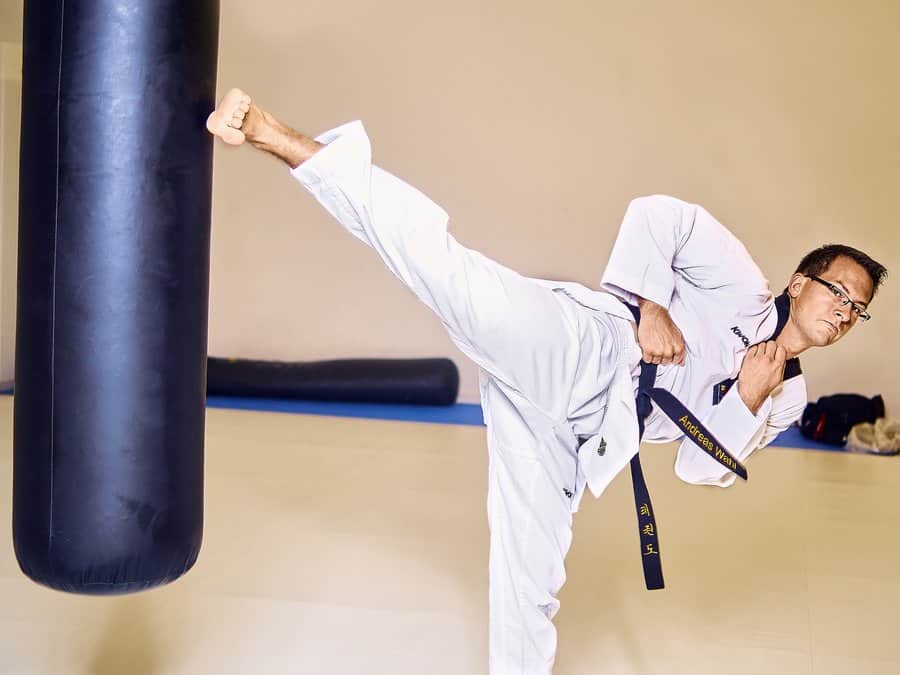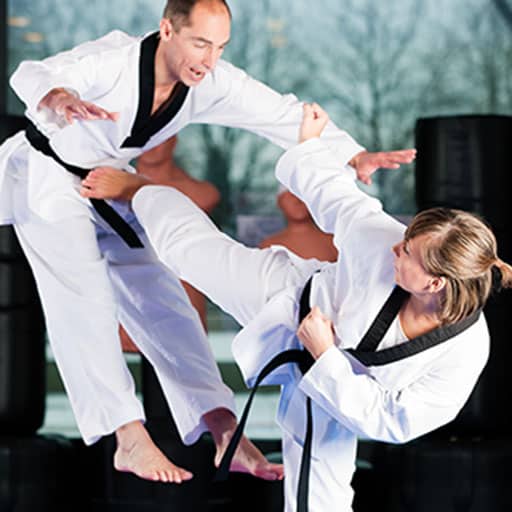
The very nature of Taekwondo training exposes its participants to injury in a variety of different situations. No matter how young or old, experienced or inexperienced, anyone can be at risk for the myriad of common injuries without taking proper care and precaution.
You might be wondering: who’s most at risk? What are the most common Tae Kwon Do injuries and when do these types of injuries occur? Are they serious? How do I reduce or even prevent the chance of it happening to me?
I’ll start off by taking a look at the two leading causes for injuries in the sport, followed by more specific tournament risks, injuries that are more prevalent for the young and old, and how to take preventative measures to reduce one’s risk.
Although it may never be possible to completely eliminate the chance of injury, following some basic precautions can go a long way in mitigating it.
Injuries in Taekwondo – Who’s at Risk and How to Prevent Them
General Injuries
When a participant in taekwondo becomes hurt, it usually falls into one of two categories: acute injuries and cumulative injuries.
The easiest way to distinguish the two is that acute injuries are a result of impact related events: such as striking your opponent, receiving a kick, or breaking a board. Acute injuries are usually a direct result of contact.
This encompasses injuries like a broken nose from a kick to the head, bruising, contusions, other broken bones, and so forth. These are also called traumatic injuries, aptly named as they arise from a traumatic event taking place.
These types of injuries include:
- Concussions from a kick to the head
- General bruising
- Broken noses
- Broken limbs
- Fractured bones
- Lacerations
- Internal organ damage, like damage kidneys resulting from strikes
Contrary to acute injuries, cumulative injuries can occur at any time, even when there isn’t contact. They could be as varied as muscle strains, torn ligaments, sprained knees, tendonitis, and more. Commonly, they are the result of chronic stress on bones and ligaments, improper care regarding warming up and cooling down, or too little stretching (or too much)
Cumulative injuries include, but not limited to:
- Hamstring or groin tears and strains (from high kicking)
- Sprained knees and ligament damage (from rotational kicking)
- Tendonitis (from repeated motions)
Essentially, while acute injuries are more likely to happen during events or practice, cumulative injuries usually result from basic wear-and-tear or incomplete training regimens; by taking proper care and precaution, these are the ones that are easier to prevent.
It’s important to note that the person receiving the kick is not the only one who is at risk for injury: the person executing the technique is also at risk. Feet, ankles, knees, and hip flexors are all particularly prone when performing one of taekwondo’s many kicks.
It’s important to execute proper technique, maintain balance, and only perform them in a matted environment where you can safely land if it goes wrong.
These types of injuries can occur during sparring, practicing, or in competition. Competitions make up a large part of taekwondo at the higher ranks – so next, we’ll dive in a little bit deeper to see what kind of risks are prevalent. After that, we’ll cover adult and youth injury risk as well as how to prevent them.
Common Tournament Injuries
When it comes time to take part in tournaments, taekwondo participants have to be extra wary as to not incur injury. Often times, there will be opponents of varying skill levels going up one another, coupled in with different methods of training, increasing the risk for traumatic injury.
There’s two facts to consider when it comes to tournaments: almost half of all injuries take place in the lower extremities, while head injuries make up for the next largest portion of injuries.
The most common type of injury impacting participants are contusions – deep bruising that occurs as a result of striking or being stricken. While contusions are generally considered less worrisome than other potential injuries, they can still create their own problems – making it hard to spar or compete at full throttle due to the pain of the injury.
Almost half of all injuries in competition are contusions. Where contusions become more serious is when they involve the head – like concussions, they create additional complications for those competing.
Besides contusions, sprains and strains are the next most common type of injury that athletes endure. These are most likely to occur to the foot and ankle. The leading cause of this type of injury is the turning kick.
Injuries More Prevalent for Older Individuals

Taekwondo is an excellent way for older individuals to become more active. In one study, it was shown to improve effective balance and overall walking capabilities for participants who were over 70 years old.
Other such health benefits include the normal effects of regular exercise and fitness, such as improved strength, flexibility, and aerobic capacity.
There is also a number of psychological benefits like improved cognition and self-esteem. Despite the overwhelming number of ways that taekwondo can positively influence older adults who participate, there comes a risk.
With how tournaments and sparring is scored in taekwondo, points are usually given for kicks to the head. This naturally leads to a higher chance of concussion, and it’s been noted in a study that taekwondo athletes have a 4 times higher chance to receive a concussion than those playing American football. This is especially true for adults, as protective equipment may not always be readily used like it is for children.
Besides the risk of contact injuries, adults may be more prone to cumulative injuries than children as well. The risk of injury for adults practicing taekwondo is largely impacted by lifestyle choices.
Healthy habits like eating well, focusing on recovering after practice, and getting enough sleep can be important to help prevent injury.
Occupations can have a large impact on adults who practice the sport. Adults who take part in more stationary jobs like at a computer will need to take proper care to warm up and cool down before participating.
A proper warm up may consist of light activity for 5 to 10 minutes followed by a short period of stretching. Without warming up, one is more prone to pull a muscle and incur other injuries.
On the flip side, someone working a very active job will need to pay special attention to rest, recovery, and eating right. One such example is that working 8 hours at a construction job only to hop immediately into taekwondo for the evening can lead to tendonitis, bursitis, and other injuries resulting from overuse.
We’ll take a deeper look into injury prevention in our final section of the article, but for now we’ll be shifting into common injuries that children may face.
Children’s Risk and Common Injuries
With children, it’s interesting to note that the more training they undergo, the less of a chance that they will be injured or injure others. Besides being better at basic techniques like kicking or blocking, studies have shown that there is an inverse relationship between a child’s taekwondo belt achievements and their aggression.
In other words, the higher your child’s rank, the less likely they will be overly aggressive while the reverse is true for children who are just starting out.
However, it’s also been shown that as children progress through taekwondo and become more comfortable, they will generate greater force with their kicks. Competitions are where children are most likely to become injured, with a much higher risk of doing so than adults.
Whereas adults may be prone due to the stresses that regular practice can create on the body, children are particularly at risk during competition. These can be range from factors like facing against other competitors for the first time (different styles), to increased levels of aggression, and the point system.
In tournaments, the United States Olympic Committee recently decided to award points for kicks to the head. Previously, children in the 12 to 13 year old age bracket would be penalized for using such kicks – but instead are now awarded points.
Overall, children are more likely to experience acute injury during taekwondo due to mismatches of experience, age, levels of aggression, and so forth. One cannot completely write-off the chance of cumulative injury though: for example, a child playing in multiple sports in a single season will need to place an increased emphasis on proper rest and recovery so that they are ready for taekwondo – whether its their nightly practice session or a big upcoming tournament.
Preventing a Tae Kwon Do Injury

The first step to preventing injury in taekwondo is to live a healthy lifestyle as to prevent cumulative injury from happening. As noted above, those that are already very active will need the proper nutrition, rest, and recovery in order to get ready for each session.
On the flip side, those that live a more sedentary lifestyle will be looking to focus more on warming up and cooling down. Overall though, the goal is to maintain good physical fitness. It will help reduce the difficulty of practicing or competing so that you can focus on technique.
If you have the intangibles taken care of, then you’ve taken the first large step to longevity in the sport. This is the hard part – doing the right routine, every time. It’s easy to skip a warm up or to practice too hard on too light of a night’s sleep, but if you can stay disciplined in this area, then taking care of the tangible risks will be much easier.
The first step is to wear proper equipment. The most important is headgear and mouth guards. Given taekwondo’s focus on striking the head, especially with powerful kicks, it’s important to be protected. Soft or other protective headgear can help reduce the overall risk of concussion and other head injury. Mouth guards are important in reducing the overall chance of dental trauma from occurring.
After headgear and mouth guards, full body padding is important to help reduce the risk of injury – both for yourself and for your opponent. Padding can be worn on the arms, chest, abdominal, and legs.
Even though it can protect you from contusions and bruising, perhaps the greatest benefit is for your opponent to be wearing it – as it helps soften the blow on your feet and ankles, the most prone areas to injury.
Pelvic and groin protectors are available for men and women as well, which can help reduce the risk of injury should a kick from your opponent go astray.
Another major factor is to maintain proper hydration during each session, whether you are practicing or at a tournament. Staying well-hydrated helps to reduce heat related stress which is produced during exercise as well as maintain normal muscular function.
Overall, it will help you maintain peak performance – and peak performance will ultimately lead to being able to better react to your opponent as well as perform your own moves correctly.
Ultimately, preventing injury comes down to doing the little things right. It is attempting to mitigate the risks in all manners, from lifestyle and technique, to practicing with those that are a similar skill level as you. No sport, taekwondo included, will ever be risk free – but with the right precautions, you can come pretty close.
Injuries in Tae Kwon Do – Are They Something You Should Be Concerned About?
No matter what sport you participate in, the risk of injury will always be prevalent. While tournaments pose a unique risk for athletes (one that is still very low when looking at the total number of participants to injuries), many people will never get to the tournament level or desire to compete in one if they do.
Proper training and precaution, along with being knowledgeable of the types of injuries that occur, can go a long way in preventing one from ever happening.



Comments 2
My, granddaughter, 13, greenbelt during her first competition got kicked about 10 them in the head by the opponent. She still complains about a headache two days later.
Should she be checked for brain injury?
Thanks
She should have been taken to the hospital or to her general practitioner.